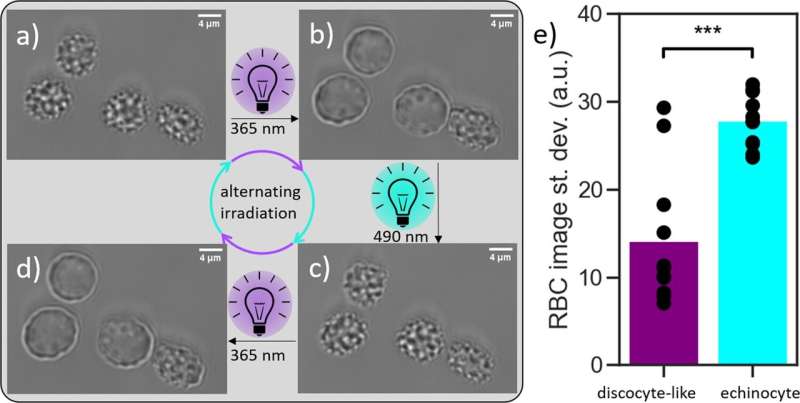This article has been reviewed according to Science X's editorial process and policies. Editors have highlighted the following attributes while ensuring the content's credibility:
fact-checked
peer-reviewed publication
trusted source
proofread
Research team shows that a cell's membrane can be reversibly deformed with light

Membranes fulfill a variety of tasks in living cells: for example, they separate the cells from their surroundings and thus protect them. Also, by means of transport proteins they convey the necessary nutrients to the interior. Membranes are also instrumental when cells grow together to form tissue, when they proliferate by dividing, or when they move.
A team of researchers led by Prof. Bart Jan Ravoo from the Institute of Organic Chemistry at the University of Münster, and by Prof. Timo Betz from the Third Institute of Physics—Biophysics at the University of Göttingen, are now the first to describe how living cells can be reversibly reshaped by targeting the cell membrane using light. The study has been published in the journal Nature Communications.
In a laboratory experiment, the team succeeded in changing the shape of red blood corpuscles. These cells are normally disc-shaped ("discocytes"), but they can also take on a prickly form with projections on the surface ("echinocytes" or "burr cells"). For their experiment, the researchers used a kind of "molecular light-switch" that they inserted into the cell membranes and that had the effect of making the cells take on the thorny burr-cell shape.
When subjected to ultraviolet light radiation, the cells changed their shape again within seconds and then looked like the flat discocytes that occur in nature. Under visual light, they again assumed their burr-cell shape. This process was repeated several times.
The basis for this change of shape is a molecule that has a similar structure to the molecules in the cell membrane and that has an additional functional unit that responds to light by changing its form: an azobenzene. "Because the azobenzene is hydrophobic—in other words, it has water-repellent properties—we additionally inserted a hydrophilic, water-soluble side chain," explains lead author Dr. Fabian Höglsperger from Bart Jan Ravoo's team.
"This is a design which comes very close to the lipid molecules found in nature in cell membranes. The differences between the azobenzene derivative, which we designed and produced, and the lipid molecules found in nature are small—but they are enough to cause a significant change in the cell membrane by means of light."
The team's explanation for the fact that the cells promptly change into the flat form when subjected to ultraviolet light is the changed structure of the azobenzene molecule. There is less likelihood of this changed molecule variant residing in the cell membrane, and the projections occurring in a membrane with the echinocyte form become flatter. When subjected to visual light, the reverse reaction is triggered in the photo-switch, and the echinocyte form regresses.
The study in question deals with basic research. But, as Bart Jan Ravoo says, "In future, this simple but efficient method could help in studying the reactions of cells to their surroundings—depending on their shape—or in using light to control processes such as cell division and cell migration."
The change of shape occurring in cells in nature is also due to the structure of the membranes. The double layer of molecules with a hydrophilic head and a hydrophobic side chain is so stable that molecules cannot readily pass through. At the same time, this layer is moveable to enable it to respond to internal and external stimuli. "As is often the case," says Fabian Höglsperger, "this change of shape is a process which occurs easily in nature but which is difficult to control under laboratory conditions."
The study brought together researchers from four institutes at the Universities of Münster and Göttingen—with their expertise in the fields of synthetic, theoretical and physical chemistry, as well as biophysics and cell biology. The methods used by the team in their work included spectroscopy and microscopy. The red blood corpuscles were human cells.
More information: Fabian Höglsperger et al, Rapid and reversible optical switching of cell membrane area by an amphiphilic azobenzene, Nature Communications (2023). DOI: 10.1038/s41467-023-39032-0
Journal information: Nature Communications
Provided by University of Münster





















